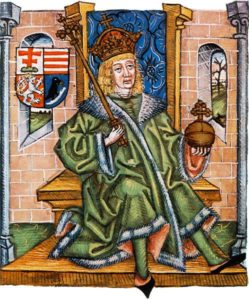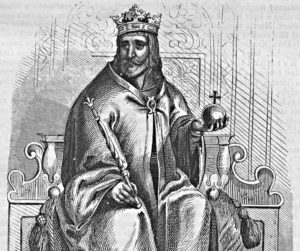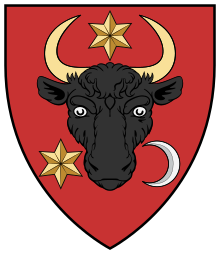Vágbeszterce
Vágbeszterce (Považská Bystrica, Waagbistritz) can be found in Slovakia, it is famous for its castle built in the 13th century Kingdom of Hungary. The castle and the settlement are closely connected to the Balassa, Mérey, and Podmanitzky families. (Please, note that I use the Oriental name order in my articles for Hungarians where family names come first.)

The ruins of the castle stand on a hilltop overlooking the Vág River at 497 meters above sea level. The castle hill may have been inhabited by the Celts, according to the coin finds found there. The date of the castle’s construction is not known. The date 1128 is mentioned in older literature, but this is not confirmed by archaeological finds. The more accepted view is that the castle of Vágbeszterce was also built in the castle construction project after the Mongolian invasion of 1241-42. Its function was to control the Vág Valley.

The first mention of the castle of Beszterce is in the document of Csák Máté issued at Bolondóc castle [Beckó] in 1316 in the form “Bestruche”. In this charter, the governor Matheus [Maté] orders Albertus to send his son to “Kasza” [Košeca (Kassa) that is situated close to Ilava, Lednica, and Vršatec castles], “Oruslanku” [Oroszlánkő], “Lednuche” [Lednic], “Bestruche{e}”, “Hrychov” [Hricsó], “Lytwa” [Litva] and “Strechun” [Sztrecsény / Strechun], and to collect from the serfs of Matheus there, for each mansion or curia, a measure of oats and a cart of hay, and to take it to Trencsén (Trenčín) without delay. After the death of Csák Máté in 1321, it became a royal castle. King Károly Róbert created the “comites Bistrichienses” with the center of Beszterce, detached fromTrencsén County.

The early castle originally consisted of an 80 x 40-meter perimeter of elongated oval defensive walls, tapering at the eastern corner. As this was the most defensible point, it may have been the core of the castle. The oval walls were reinforced by two towers. In the second half of the 14th century, a tower was added to the southern side. In the 15th century, the southern part of the courtyard was built up and the eastern part of the castle was separated. In the second half of the 16th century, additional buildings were added along the inner side of the walls in the southern and northwestern parts of the courtyard. The gate was moved to the east and reinforced by a semicircular gate tower projecting from the plane of the wall.

In 1325, the (Vág) Beszterce castle was granted to the Country Magistrate Köcski Sándor, a descendant of the Héder clan, as an estate of honor (temporary use), together with several castles along the Vág. In the charter, he names himself Castellan of Beszterce and the other castles around it (‘Alexander iudex curie domini regis castellan usque de Bistriczia et Prorumque castrorum in circuitu’). Throughout the 14th century, these castles were the benefice of the current country’s magistrates.

In 1339, Comes and Country Magistrate Nagymartoni Pál had two vice-castellans in Beszterce, Gogan and Aman (“nos magistri Gogan at Aman vices castellani comitis Pauli iudicis curie domini regis in Bistricia significamus… “).
In 1351, Szécsényi Tamás, the king’s Country Magistrate, issued a so-called “soltész letter” because “the possessions under his honor (power) were bound by law to be settled” (possessiones sub nostro nunc honore existentes prout de iure tenemur populosas efficere). In any case, both he and the other country magistrates took this right very seriously, and a whole series of villages were established in the royal manors around Beszterce and Zsolna.

In 1354, it was owned by Ugali Pál, a former Bán (Duke) and Country Magistrate. In 1362, Country Magistrate Bebek István was the landowner of the land. In 1376, it was Country Magistrate Szepesi Jakab who owned Nagydomanisa, which belonged to the castle of Beszterce castle. Losonci István’s sons, László and István, appeared twice in 1385 as the Chief Comes of Beszterce (comites inter cetera Bystrichienses, comites in Bystricia).

In 1392 it was Kaplai János, Bán (Duke) of Szörény from the Rátót Clan, a former king’s magistrate who received it from King Zsigmond (Sigismund), but he took it back from him in 1397, citing the decrees of Temesvár. On 6 September 1397, King Zsigmond granted Beszterce and four other castles to the Polish palatine Sandsilvogius (Szandzivoj / Zandziwogius) of Kalisz by life tenure. In his charter dated 23 May 1399 in Tarnov, Sandsilvogius, lord of the castle of Beszterce, transferred the military service of Podmansky (Podmaniczky ancestor) Silvanis from two spearmen to one spearman.

In 1404, the castle was in the hand of a favorite general of King Zsigmond, the Transylvanian Voivode Stibor, he was the Comes of Beszterce. From 1414 it became a royal castle again, and in 1419 it was pledged to Duke Louis II of Silesia of Lysnitz and Brieg – and remained with him until 1421.

In 1424, a charter from Prince Albert of Austria and Margrave of Moravia revealed that Queen Cillei Borbála had received back the estates given to her by King Zsigmond and then taken away. These included the castle of Trencsén and the whole county, the castles of “Zucchya” (Szucsa), “Orozlankw” (Oroszlánkő), “Bistricia” (Beszterce), “Hrychow” (Hricsó), “Strechen” (Sztrecsény), and “Owar” (Óvár / Varin) and their appurtenances, and the lands of the destroyed castle of “Bugyetin” (Budetin).

In November 1432, the nearby Lednic castle was captured by invading Czech Hussites. In 1433, their troops, who had also ravaged Szepes Region and Liptó, destroyed the town of Vágbeszterce (“oppidum nostrum Byzthricza”). The castle was also burnt down during the Hussite fighting. On 6 September 1435, King Zsigmond confirmed the privileges of the (Vág)Beszterce market town, which was destroyed during repeated Hussite raids. The charter mentioned the judges András and György.

After King Zsigmond’s death, King Albert Habsburg confiscated his mother-in-law’s estates (so that she could “do less harm in her wickedness”) and donated them to his wife, Queen Elizabeth of Luxembourg, in 1439 (“Idem Albertus Conthorali suae Elisabeth arcem et vrbem Trenchin, Leua, Castrum Szucha, Oroszlankew, Byztricze, Strechen, ciuitales item Warinuin, Solnam, et Castrum Owar confert.”).

Queen Elisabeth didn’t keep it for long, she pledged it to her relative, Cillei Ulrik. In 1438, King Albert, with the consent of his wife, carved out three estates from the manor of Beszterce Castle (Marykowalehota, Kleschyna, and Katlyna) and gave them to Pál László of Hathna and his brothers for their military merits. In 1439, the following 17 estates were part of the castle’s domain: the town of Beszterce, Marikova, Hlinik, Styavnik, Plevnik, Domanis, Orlóv, Rassov, Lednice, Tepla, Praznó, Katlina, Predmér, Hvoznica, Krebrenovalehota, Vertizsér, and Klesztina.

Between 1440 and 1444, during the internal wars between the pro-Ulászló and pro-Elizabethan forces, the castle of Beszterce was under the rule of the widow Queen’s supporters. On 1 June 1454, on the orders of King László V., Cillei Ulrik had to cede the castles of the Vág Valley (Trencsén, Beszterce, Illava, Oroszlánkő, Sztrecsény, Szúcsa, and Zsolna) to Governor Hunyadi János in exchange for 13,000 gold Forints.

On 15 March 1458, King Matthias Corvinus granted the castle of Beszterce in Trencsén County, the town of Beszterce, “Teppla, Verchiser, Plewnyk, Rassow, Predmyer, Lednicze, Domanyse, Preznew, Orlowe, Podhradye, Felsewpodwase, Chewnyk, Kebrenowalhota, Hwaznicze, Ffelsewteppla, and Chernacokoztelecz” (these are the forms of the settlements from the document), all the estates of Trencsén County and all other revenues belonging to the castle to Podmaniczky László who was the nobleman serving the Hunyadi family. According to the justification, Podmaniczky had served Hunyadi János and László loyally, and the latter also owed him 1200 gold Forints. Podmaniczky also worked with Szilágyi Mihály to elect Matthias (the son of Hunyadi) as king.

On 03 September 1460 King Matthias, considering the merits of Podmanyczky László of Podmány, allowed him to collect tolls between the possessions of “Werchyseer and Plewnyk” in Trencsén County, which belonged to Beszterce castle, but he had to build bridges in the watery and marshy places at his own expense.

On 12 April 1464, King Matthias issued a document in favor of Podmaniczky László, in which he confirmed his rights to hold the castle, the market town, and other estates of Beszterce in Trencsén County. The king confirmed it with his seal before his coronation.
In 1485, the Podmanickys already used the name “Besztercei” (meaning: “of Beszterce”): “generosus dominus Ladislaus de Podmanyn alias de Bistricz”. The castle was mentioned in the charter as “Castrum Bistriciense”. Around 1489, Podmaniczky János inherited the castle and manor of Beszterce, which he considerably enlarged within a decade and a half.

In 1526, Podmaniczky István, Bishop of Nyitra, escaped from the Battle of Mohács, and because of the death of the Archbishop of Esztergom, he put the crown on the head of Szapolyai János in Székesfehérvár. He also crowned King Habsburg Ferdinand I in 1527 with the same crown. Because of his betrayal, the then pro-Szapolyai nobleman, Török Bálint received Nyitra from King Szapolyai.

However, Rafael and János, the two sons of Podmaniczky Mihály who had fallen on the battlefield of Mohács, remained loyal to King Szapolyai János and took advantage of the internal war to become real robber knights. King Habsburg Ferdinand’s commander Katzianer tried to put a stop to the Podmaniczky raids in 1529, but the castle of Beszterce successfully resisted. The pro-Habsburg Serédy Gáspár, however, captured several Podmaniczky estates, and in 1531 King Szapolyai gave them the castle of Palota as compensation. They also turned the castle of Bakonyújvár in the Bakony Mountain into a raider’s nest and plundered the area from there.

In 1531, Török Bálint would have received the castle of Pápa from King Ferdinand I in exchange for the castle of Nyitra. This was not enough for Török, but he would have been willing to take the castle of Vágbeszterce (“Bystrych”) from the Podmaniczkyi. Török wanted to get a high price for betraying King Szapolyai.

Because of the robberies of the Podmaniczky brothers, the Diet of 1542 passed a special law against them (Act 44 of 1542):
“Furthermore, it is known to the nobles of the country, among other things, that Podmaniczky János and Raphael, having done nothing to observe public order and the law, not thinking that the country was in danger of ruin, have not to this day returned to the loyalty and obedience of his Majesty; And they have not thought of returning the castles and strongholds, both ecclesiastical and temporal, which they have taken by force in these years, and all their properties and possessions; and even now they have not ceased to commit continual tyrannies and other evils against the inhabitants of the country; therefore, it is decreed, that within two months from the last day of this present assembly, by King Ferdinand’s allegiance, all the castles, towns, and villages which they have taken shall be returned to their rightful owners and that if they fail to do so they shall be exiled as branded infidels.” They finally surrendered to the king and were acquitted by the Diet of Nagyszombat in 1545. Meanwhile, in 1543, a fire destroyed the castle.

Podmaiczky János died around 1545 and, in the absence of a successor, Rafael inherited his shares of the estate. At the Diet of 1546, Rafael’s rebelliousness was again the subject of discussion. In 1558, Podmaniczky Rafael, the Archbishop of Trencsén, died without an heir. The extensive family estates reverted to the king. Everything was given to Serédy Gáspár in 1560. During Serédy’s tenure, the castle underwent major construction. In 1571, Balassa András married Serédy Gáspár’s widow, Mérey Anna, and with her hand he received Vágbeszterce. The Balassa family owned the estate until 1860.

In March 1582, Balassi Bálint invited the lords of the age to the wedding of his two sisters, Anna and Mária, at Vágbeszterce, owned by Balassa András. Mária married Bánffy János of Alsólindva and Anna married Forgách Miklós of Gimes. In September 1583, Balassi Bálint agreed here with his relative about the estates of Végles and Gyarmat.

Balassa András died on 21 October 1591 in Vágbeszterce. In 1605, the pro-Bocskai lord, Balassa Zsigmond captured his pro-Habsburg brother Imre and confiscated his property. Imre was freed and his estates returned to him only after the Treaty of Vienna in 1606.
In 1616, the royal troops besieged Balassa Zsigmond in his castle in Kékkő. The fleeing lord was captured and could only return to Beszterce 3 years later. In July 1621, Thurzó Imre, waiting for Prince Bethlen Gábor’s auxiliaries, on his way to the camp of Vistula, stopped under Beszterce and forced Balassa Zsigmond to swear fealty to Bethlen. Bethlen made a special request to Thurzó in a letter dated 18 March:
“…it would be very good for your lordship to find some way to get [Balassa] out of Beszterce and I would come to him … if he does not want to come, it would be good for me to persuade him to come and bring him against his will…”

Perhaps because of the Balassa’s quarrels and the castle’s obsolescence, 3 fortifications were built near the castle: the first in 1631, the second, and the third in 1676. After 1631, the castle was no longer inhabited by the family, who moved to the much more comfortable fortified palace below the castle. In February 1648, Balassa III Imre excluded his mother from the manors of Eberhard, Divény, Kékkő, Vágbeszterce, and Gyarmat.

According to a 1664 charter, half of the castle and two fortifications of Beszterce belonged to Balassa Imre, while the other half of the castle and a third fortified building belonged to Balassa Zsigmond. The pay of the castle’s castellan, officers, and riflemen was provided by the inhabitants of the surrounding villages. In addition to money, grain (wheat or rye) was also due.

Photo: Szegedi Szabolcs
Balassa Imre became involved in the Wesselényi conspiracy, and the castle of Beszterce was captured by royal troops in 1671. In that year, an inventory charter was drawn up for (Vág) Beszterce, which had been confiscated from Balassa Imre and fell into the hands of the Treasury. Balasa Imre had properties in the following settlements (fully or partly): Podhragy, Praznó, Styavnik, Plevnik, Nagyudicsa, Marikova, Kliestiná, Zaszkalja, Sebestyénfalva, Podvázs, Vágbeszterce, Verchtepla, Precsény, Dolina, Kosztelecz, Facskó, Hatne, Praznó, Styavnik, Marikova, Rakova. Then, Balassa Imre fled to Transylvania. In 1674 all the armaments of the castle were transported to Lipótújvár.

In 1683, after the unsuccessful siege of Vienna, the fortune of the Turkish ally, Prince Thököly Imre was running out. In 1684, Imperial troops captured the castle from the anti-Habsburg Kuruc troops and burned it down. According to the castle’s Slovak-language website, its final destruction took place in 1698, when it was blown up by an Imperial order to prevent it from becoming a stronghold of the rebels.

However, this is contradicted by the correspondence of the Kuruc brigadier Ocskay László. According to these, it was still used by the Kuruc troops during the Rákóczi War of Independence. In the autumn of 1707, after his successful raid on Beckó castle, Ocskay fortified the small fortresses still in Kuruc’s hands: Lednice, Kaszavár, Oroszlánkő, Vág-Beszterce, Bicce, Budatin, Óvár, and Lietava.

Except for Óvár, he found the castles in a very neglected state and almost empty. From Érsekújvár, Esterházy Antal sent 300 Hajdú soldiers and 8 howitzers under the command of Vilmos Winkler to these castles. According to Winkler’s reports written at the end of October, he found the castles not well supplied. Lednice did not even have a rod for loading cannons, Beszterce was short of water – he asked for miners to clean the well. In Lietava, too, the well had to be cleaned out. Here the workers found 12 German prisoners who had been prisoners in the well for 2 years.

Ocskay’s troops camped at Vágbeszterce in early March 1708, from where he wrote to Bercsényi. In August, Imperial Lieutenant-General Carl Hochberg von Hennersdorf marched under Oroszlánkő castle with 800 men, but the castle did not surrender. The general retreated from Ocskay’s troops. Ocskay wrote a letter to Bercsényi asking him to send reinforcements to hold the castles and lands.

Soon after the lost battle of Trencsén, Ocskay betrayed Prince Rákóczi II Ferenc and switched to the Imperial side. Ottlyk György took his place, but with his insufficient forces, he had to leave Trencsén County. Only the garrisons of the smaller castles of Lednic, Óvár, Budatin, Lietava, and Beszterce remained loyal to the Kuruc cause. Ottlyk could not support the castle garrisons, they fell one after the other. Bajmóc, relatively well fortified, was captured by Pálffy through the treachery of Thúróczy, while the garrison of Beszterce was forced to surrender to the besieging army of the Imperial Lieutenant General von Hennersdorf in early December 1708. This is the last record of the castle’s use.

In 1712 the seized Balassa estates were bought by the Szapáry family, and Szapáry Péter married Balassa Terézia. They built the large palace, now in ruins, under the castle hill. The walls of the already battered castle were no longer repaired, they were crumbling. On 15 February 1858, an earthquake caused the collapse of the still-standing tower of the ruined castle. In 2016, excavation and conservation work began on the ruins of the castle.
Source: Várlexikon https://varlexikon.hu/vagbeszterce-var

Dear Readers, I can only make this content available through small donations or by selling my books or T-shirts:
Please, feel free to support me with a coffee here:
You can check out my books on Amazon or Draft2Digital, they are available in hardcover, paperback, or ebook:
https://www.amazon.com/dp/198020490X or at https://books2read.com/b/boYd81

My work can also be followed and supported on Patreon: Become a Patron!http://Become a Patron!
[wpedon id=”9140″]

https://hungarianottomanwars.myspreadshop.com/all


























































